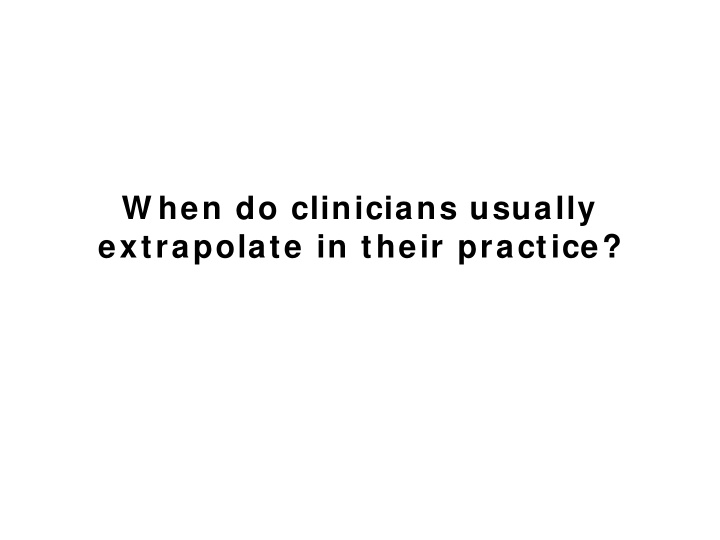



W hen do clinicians usually extrapolate in their practice?
Clinical approach « Extrapolation refers to the use of an em pirical rule outside its field of validation »
Frequent Extrapolation approaches in Clinical setting 1 / ‘dow n/ up’ the age class 2 / betw een m edicines belonging to a class 3 / from one disease to another, from one stage/ line to another 3
Frequent Extrapolation approaches in Clinical setting 1 / dow n/ up the age class 4
Frequent Extrapolation approaches in Clinical setting 1 / dow n/ up the age class 5
Rare Extrapolation approaches in Clinical setting 6
Rare Extrapolation approaches in Clinical setting Cystic fibrosis Congenital disorders (orphan conditions) … 7
Rare Extrapolation approaches in Clinical setting Cystic fibrosis Congenital disorders (orphan conditions) … 8
Presentation title (to edit, click 9 View > Header and Footer)
1 / sam e m edicine ‘dow n/ up’ the age classes epsy • Facing sam e disease ? FOCAL GENERALISED IDIOPATHIC 10 years Reading epilepsy Adolescent Acquired epileptic absence Aphasia epilepsy 2 years JME Epilepsy with CT spikes BMEI Childhood Epilepsy 1 month Absence with GTCS BIFS epilepsy on BIS awakening BFNS BNS Doose syndrome WEST EI EE Symptomatic or cryptogenic focal EME epilepsies IDIOPATHIC MPSI Lennox Gastaut E. partialis syndrome continua Dravet syndrome & NON E. With myoclonic Epilepsy absences with CSWS Sylvie N'Guyen • Bio-availability is sim ilar • PK is linear Dose response is sim ilar ( PD) • or... 10
1 / sam e m edicine dow n/ up the age class m ore robust at hand of a surrogate m arker of efficacy ( not necessarily safety) HPV antibody response Vaccine 1600 Efficacy Program 1300 Anti-HPV 6 GMTs 1100 900 700 Immunogenicity Bridge 500 9 10 11 12 13 14 15 16 17 18 19 20 21 22 23 Age at Enrollment (Years ) 12
‘ 1 / sam e m edicine ‘dow n/ up’ the age class or targeting an ‘external’ pathogen Antibiotics in... CAP I CU ResistP 13
2 / betw een different m edicines belonging to a sam e class used for a specific disease Drug/ pro-drug • ( [ des] loratadine...) • Bio-equivalence ( Release form ulation, conversion factor) Therapeutic equivalence • ( anti-TNF in MS, Blood factor substitution, ERT) ( vaccines, based on sero-conversion factors) ( one statine to another, m onitored by LDL-Chol) ) • Me-too, is not equi-potency ( for E [ long term effect statines] &/ or S...) 14
3 / sam e m edicine from one disease/ sym ptom to a sim ilar, from one stage to another pain / fever • • leukaem ia/ lym phom a • arthritis… • HTA [ prim ary,secondary] / heart failure Allergy/ exercise induced asthm a • Heart failure stage I ,I I ,I I I ,I V • • Cancer stage, relapse... 15
How do Clinicians behave? I nterlinking • Mechanism of action of the disease ( pathogenesis/ pathw ays) • Mechanism of action of the drug ( target, receptors) • Clinical condition/ presentation ( individual sign & sym ptom s)
W ithin sam e ‘nosological’ entity
Across sam e ‘pathological pathw ays’
CHMP COMP Clinicians Product Disease MoA Indication Designation Conditions PDCO PDCO
Summary Extrapolation in use based on Clinical intuition • Signs & symptons (presentation) • Knowledge of the disease (pathogenicity) • Mechanism of action drug (target) • Personal experience (off-label)
We are working on it 22 22
Recommend
More recommend